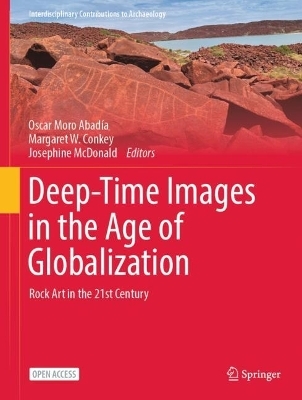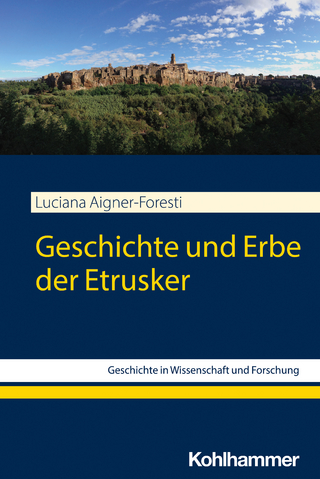
Deep-Time Images in the Age of Globalization
Springer International Publishing (Verlag)
978-3-031-54637-2 (ISBN)
This open access volume explores the impact of globalization on the contemporary study of deep-time art. The volume explores how early rock art research's Eurocentric biases have shifted with broadened global horizons to facilitate new conversations and discourses in new post-colonial realities. The book uses seven main themes to explore theoretical, methodological, ethical, and practical developments that are orienting the study of Pleistocene and Holocene arts in the age of globalization. Compiling studies as diverse as genetics, visualization, with the proliferation of increasingly sophisticated archaeological techniques, means that vast quantities of materials and techniques are now incorporated into the analysis of the world's visual cultures.
Deep-Time Images in the Age of Globalization aims to promote critical reflection on the multitude of positive - and negative - impacts that globalization has wrought in rock art research. The volume brings new theoretical frameworks as well as engagement with indigenous knowledge and perspectives from art history. It highlights technical, methodological and interpretive developments, and showcases rock art characteristics from previously unknown (in the global north) geographic areas. This book provides comparative approaches on rock art globally and scrutinises the impacts of globalization on research, preservation, and management of deep-time art. This book will appeal to archaeologists, social scientists and art historians working in the field as well as lovers of rock art.
Oscar Moro Abadía is a Professor at Memorial University of Newfoundland (Canada). He specializes in the study of Pleistocene art. In 2013, he co-edited, with Christoph Huth, a special issue entitled 'Speaking materials. Sources for the History of Archaeology' for the journal Complutum. In 2020, he co-edited with Professor González Morales a special issue on Pleistocene and Holocene arts for the Journal of Archaeological Method and Theory. In 2021, together with Martin Porr, he co-edited Ontologies of Rock Art: Images, Relational Approaches and Indigenous knowledges for Routledge. His research on Paleolithic art and the history of science has been published in Cambridge Archaeological Journal, Journal of Archaeological Research, Journal of Archaeological Method and Theory, World Art, History of Human Sciences, History of Science, Journal of Anthropological Research, Journal of Social Archaeology, and Studies in History and Philosophy of Science.
Margaret W. Conkey is the Class of 1960 Professor Emerita of Anthropology at the University of California, Berkeley. One key focus of her research has been the interpretations of European Paleolithic imagery, and she has carried out the Between the Caves project, a Paleolithic landscape survey in the Ariège region of France. More recently, she has been a co-director of excavations at Peyre Blanque, a Magdalenian open-air site. She has long been involved in the pioneering research on feminist and gender perspectives in archaeology. She has served as President of the Society for American Archaeology as well as for both the archaeology and feminist associations within the American Anthropological Association. Among her many awards she was the recipient of the prestigious Thomas H. Huxley Memorial Medal of the Royal Anthropological Institute (UK) for her distinguished contributions to Anthropology.
Josephine McDonald is the Director of the Centre for Rock Art Research and Management at University of Western Australia where she holds the Rio Tinto Chair in Rock Art Studies. She has published widely in the field of rock art research. She has recently led a team of researchers, Aboriginal community, and Industry collaborators to document the values of the National Heritage Listed Dampier Archipelago (Murujuga) uncovering evidence for ancient settlements and more recent inscribing behavior around these coastal desert islands.
Introduction. Deep-Times Images And The Challenges Of Globalization (Oscar Moro Abadía, Margaret Conkey, Jo McDonald).- Part I. Recentering Rock Art.- Chapter 1. 'Out Of Franco-Cantabria': The Globalization of Pleistocene Rock Art (Aitor Ruiz-Redondo).- Chapter 2. Some Implications of Pleistocene Figurative Rock Art in Indonesia and Australia (Adam Brumm, Adhi Agus Oktaviana, Maxime Aubert).- Chapter 3. Rock Art, Modes Of Existence, And Cosmopolitics: A View From The Southern Andes (Andrés Troncoso).- Chapter 4. Regional Reponses to Global Climate Change: Exploring Anthropomophic Depictions in Rock and Mobiliary Art Expressions from the Kimberley and Europe during the Late and Terminal Pleistocene (Peter Veth, Sam Harper, and Martin Porr).- Part II. Comparative Views on Global Art.- Chapter 5. The Divide Between 'European' And 'Indigenous' Rock Arts: Exploring A Eurocentic Bias In The Age Of Globalization (Oscar Moro Abadía, Amy C. Chase).- Chapter 6. Rock Art Research and Knowledge-Production in the Context of Globalisations. A Comparative Approach to the Cases of Patagonia-Argentina and Eastern Canada (Danae Fiore, Bryn Tapper, Dagmara Zawadzka, Agustín Acevedo).- Chapter 7. The Framework for Ochre Experiences (Foes): Towards A Transdisciplinary Perspective on the Earth Material Heritage of Ochre (Elizabeth C. Velliky, Tammy Hodgskiss, Larissa Mendoza Straffon, Heidi Gustafson, Ann Gollifer, Magnus Haaland).- Chapter 8. Why Do Old Dates Fascinate Prehistorians? (Georges Sauvet).- Part III. Interdisciplinary Global Rock Art.- Chapter 9. What Were Rock Art Sites Like In The Past? Reconstructing the Shapes of Sites as Cultural Settings (Jean-Jacques Delannoy, Bruno David, Kim Genuite).- Chapter 10. The Earliest Dated Pictures in the Dispersal of Psychologically Modern Humans: A Middle Paleolithic Painted Rock Shelter (C. 45ka) At Wadi Defeit, Egypt (Whitney Davis).- Chapter 11. Understanding Rock Art: What Neuroscience Can Add (John Onians).- Chapter 12. "... And Those Who Expect To Return To The Source Will Find Fog": Resonances of Prehistory in Modern Art (Rémi Labrusse).- Part IV. Tensions in Rock Art Management: Local Vs Global.- Chapter 13. The Unesco World Heritage List In A Globalized World: The Case Of The Paleolithic Caves Of Northern Spain (1985 - 2008) (Eduardo Palacio-Pérez).- Chapter 14. Local - National - Global: Defining Indigenous Values of Murujuga's Cultural Landscape in the Frame of International Patrimony (Amy Stevens and Jo McDonald).- Chapter 15. Out of Place: Postcolonial Legacy and Indigenous Heritage in South Africa (Silvia Tomásková).- Chapter 16. Graffiti, Vandalism and Destruction: Preserving Rock Art in a Globalized World (Paul S.C. Taçon).- Part V. Rock Art and the Challenges of the Global Now.- Chapter 17. Translation and Transformation: The Materiality of Rock Art in a World of Bytes (John Robb).- Chapter 18. Cultures of Appropriation: Rock Art Ownership, Indigenous Intellectual Property, and Decolonisation (Jamie Hampson, Sam Challis).- Chapter 19. Replicated Temporality. Time, Originality, and Rock Art Replicas (Laura Mayer, Martin Porr).- Chapter 20. Slow Science but Fast Forward: The Political Economy of Rock Art Research in a "Globalized" World (Margaret W. Conkey).- Index.
"This volume is filled with information and thought-provoking ideas and it succeeds in giving a critical reflection of the drastic and rapid changes in research brought about by globalisation and improved scientific methods, and delivers an established theoretical context that incorporates Indigenous knowledge. The publication is an invaluable source for anyone who is interested in rock art and it brings readers up to date on the research history... ." (Antiquity, Vol. 98 (402), December, 2024)
| Erscheinungsdatum | 14.05.2024 |
|---|---|
| Reihe/Serie | Interdisciplinary Contributions to Archaeology |
| Zusatzinfo | VII, 317 p. 97 illus., 85 illus. in color. |
| Verlagsort | Cham |
| Sprache | englisch |
| Maße | 210 x 279 mm |
| Themenwelt | Geisteswissenschaften ► Archäologie |
| Geschichte ► Allgemeine Geschichte ► Altertum / Antike | |
| Sozialwissenschaften ► Ethnologie | |
| Sozialwissenschaften ► Soziologie | |
| Schlagworte | Archaeology and globalization • Art Historical Theory and Method for Rock Art Appreciation • Artifact and art at Diepkloof Rock Shelter • Deep-time imagery • European Palaeolithic cave art • Globalization and material culture • Holocene arts • Indigenous knowledges • Indonesia's Pleistocene rock art • Indonesia’s Pleistocene rock art • Neuroscience and Understanding Rock Art • open access • Perceptions of Indigenous identity • Pleistocene arts • Postcolonial Legacy and Indigenous Heritage in South Africa • Recent advances in archaeological research • Rock art and cultural heritage • Rock art and time-averaged buried deposits in archaeology • Rock art finger fluting and hand stencils • Rock Art, Modes of Existence and Cosmopolitics • Rock art research and knowledge-construction |
| ISBN-10 | 3-031-54637-7 / 3031546377 |
| ISBN-13 | 978-3-031-54637-2 / 9783031546372 |
| Zustand | Neuware |
| Informationen gemäß Produktsicherheitsverordnung (GPSR) | |
| Haben Sie eine Frage zum Produkt? |
aus dem Bereich


